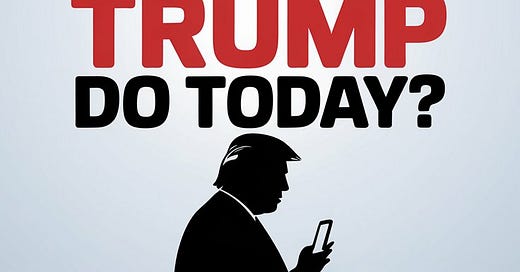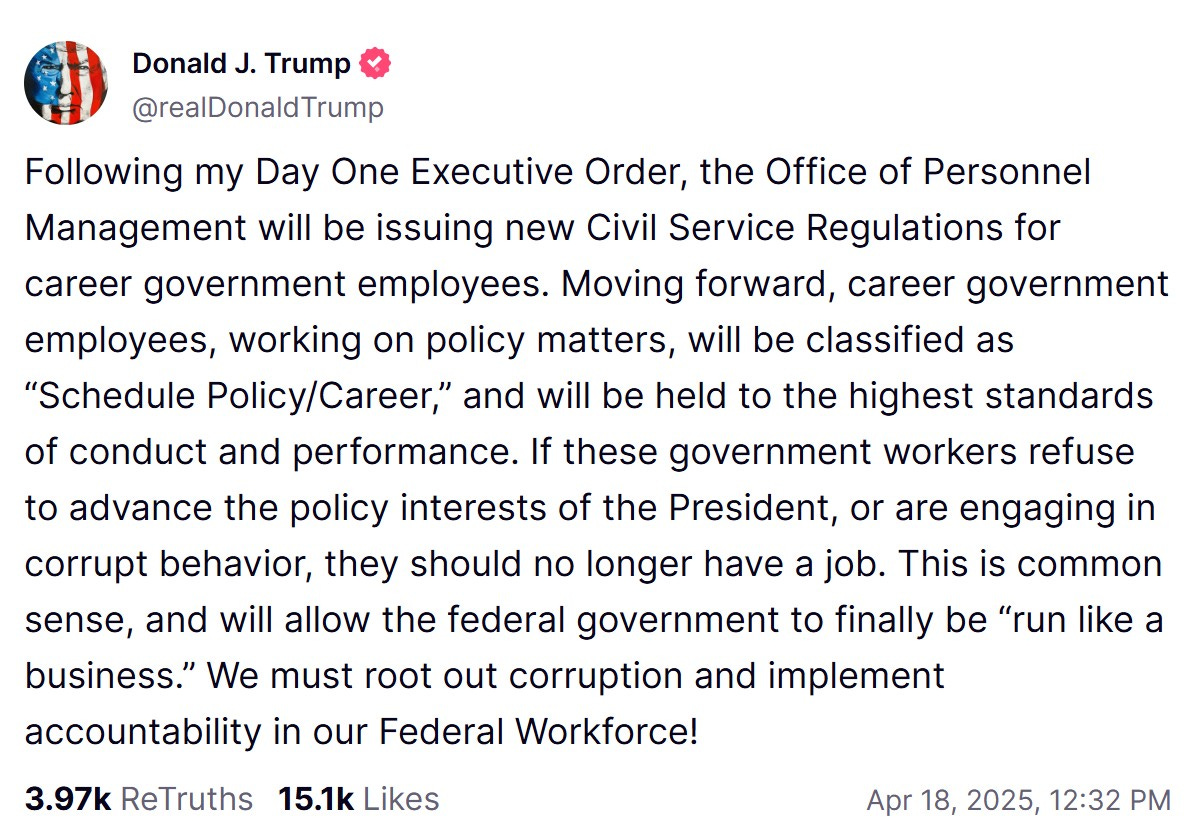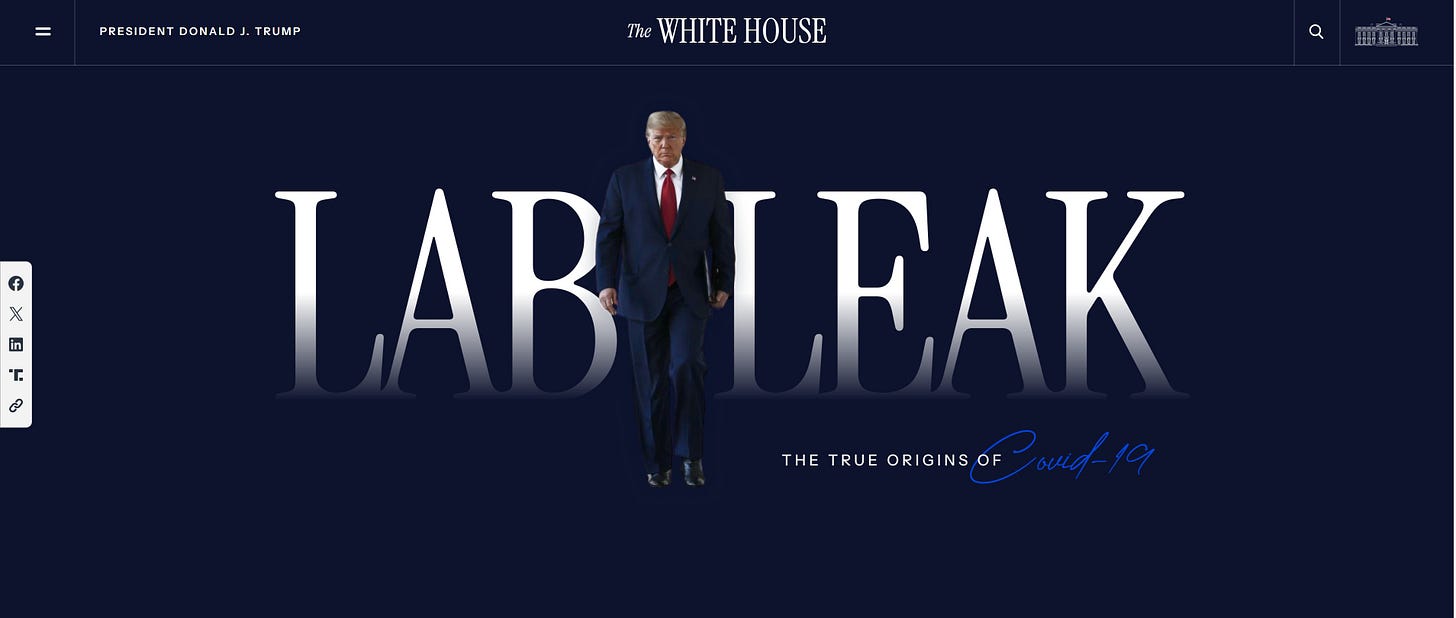Donald Trump issued another early morning Truth Social post signaling a continued effort to erode the nonpartisan foundations of the U.S. civil service by proposing a reclassification scheme that threatens to politicize federal employment. His call to create a new “Schedule Policy/Career” category for career civil servants working on policy matters effectively revives and expands upon the controversial “Schedule F” initiative from his first term, which was widely criticized as an attempt to purge the bureaucracy of perceived ideological opponents.
Framing the proposal as “common sense” and likening government to a business misrepresents the function of a democratic civil service. Unlike private sector employees who serve shareholders, civil servants are tasked with upholding the Constitution and implementing laws regardless of which party controls the executive branch. The expectation that these employees must “advance the policy interests of the President” conflates loyalty to the law with loyalty to a single political figure — a deeply anti-democratic standard.
Furthermore, the post’s vague invocation of “corrupt behavior” and performance standards provides no meaningful criteria or due process guarantees. It risks enabling retaliatory dismissals of employees who offer independent legal or policy analysis — a core function of any competent government. By suggesting that disagreement with the president’s policy goals is tantamount to misconduct, the proposal undermines the integrity, independence, and institutional memory that career civil servants provide.
Finally, the rhetoric about “running the government like a business” is a persistent but flawed analogy. The public sector exists to provide equitable service and enforce the law, not to maximize profit or efficiency at the expense of rights, stability, or lawful dissent. Trump’s post reveals a disregard for civil service protections and a broader disregard for the constitutional checks that guard against executive overreach.
Donald Trump’s Oval Office swearing-in ceremony for Dr. Mehmet Oz as the new Administrator of the Centers for Medicare and Medicaid Services was a disjointed event that blurred the lines between official duty and campaign spectacle. Trump’s remarks were characterized more by off-the-cuff jokes, personal anecdotes, and effusive praise than by a coherent explanation of Dr. Oz’s qualifications or policy vision. While Oz’s credentials include a Harvard undergraduate degree, a medical degree from the University of Pennsylvania, and a high-profile medical career, Trump focused more on his television fame and personal experiences watching Oz’s show than on his administrative preparedness. Jokes about being told to lose weight and Trump’s casual references to Harvard undermined the formality of the occasion, reducing what should have been a serious confirmation moment to a theatrical gesture.
Dr. Oz’s remarks began with gratitude and a nod to public service but quickly shifted into vague idealism and political signaling. He described healthcare as a moral obligation and emphasized that chronic disease should be tackled through individual responsibility, framing personal health as a “patriotic duty.” While some of his concerns about medical costs, fraud, and inefficiency are legitimate, his solutions were largely rhetorical and lacked operational detail. References to creating a CMS “war room” and invoking executive orders sounded more like partisan applause lines than grounded administrative commitments. His alignment with Trump and Robert F. Kennedy Jr., portrayed as visionary disruptors, further signaled a politicized vision of public health, rather than one rooted in data or institutional continuity.
The event devolved further during the Q&A session, which Trump used to revisit his usual themes: blaming President Biden for the Russia-Ukraine war, claiming credit for falling inflation, attacking Fed Chair Jerome Powell, and reiterating his belief that the 2020 election was stolen. His comments on Ukraine were especially contradictory, swinging between calling for a quick peace and downplaying U.S. involvement, all while providing questionable statistics about battlefield casualties. His inflation claims, such as gasoline prices falling to $1.98 and egg prices dropping 87%, were not supported by any credible economic data and reflect a pattern of cherry-picking or exaggerating metrics to create a political narrative.
Most concerning was Trump’s inflammatory rhetoric on immigration. He framed deportations under the Alien Enemies Act as necessary and justified, describing migrants as criminals, gang members, and “insane asylum” escapees, without offering evidence or due process standards. His comments about Kilmar Abrego Garcia, a Salvadoran immigrant residing legally in the U.S., who was abducted by ICE and sent to a maximum security prison in El Salvador without due process, were theatrical and graphic, designed to inflame rather than inform. He used the case to attack Democrats, the media, and immigration courts, conflating individual criminal allegations with broad policy justification for mass deportations. This approach undermines constitutional norms and civil liberties in favor of fear-based governance.
Ultimately, the swearing-in ceremony served more as a platform for grievance politics than a substantive policy rollout. Dr. Oz’s appointment, while framed as a bold move to “make America healthy again,” was overshadowed by Trump’s erratic delivery, politicized framing, and disregard for institutional norms. What should have been a serious introduction of a new health administrator became yet another stage for Trump’s personal narratives, media antagonism, and apocalyptic vision of America under his opponents.
Source: Fox News YouTube Channel
A federal judge declined to take immediate action against the Trump administration despite its ongoing refusal to fully comply with an order allowing The Associated Press access to presidential events. The dispute began when the White House banned AP journalists from covering events in smaller venues like the Oval Office and Air Force One due to the outlet's refusal to adopt President Trump's preferred name for the Gulf of Mexico — the "Gulf of America."
U.S. District Judge Trevor McFadden previously ruled in favor of the AP, affirming that the ban likely violates the First Amendment by punishing a media outlet for its editorial choices. However, he declined to enforce further action, stating it is too early to judge full noncompliance and that he does not intend to micromanage the White House. While AP photographers have been allowed back into some events, reporters have not yet been fully reinstated. The AP argues that the White House’s new, limited-access policy is retaliatory and undermines the court’s ruling.
Judge McFadden acknowledged potential “malicious compliance” but said he must assume good faith for now. The broader legal issue—whether a president can unilaterally control press access to official events—remains unresolved and is expected to continue through higher courts. The Trump administration has signaled it will appeal the ruling.
A federal judge has temporarily blocked the Trump administration from proceeding with a plan to fire hundreds of Consumer Financial Protection Bureau employees. U.S. District Judge Amy Berman Jackson expressed concern that officials are not complying with her earlier order preserving the bureau's operations pending the outcome of a lawsuit challenging its dismantling. She prohibited any mass firings or denial of system access for employees on Friday and scheduled a hearing for April 28 to examine the reduction-in-force plans. The administration’s proposal would cut the CFPB’s staff from approximately 1,700 to 200 employees. The move aligns with President Trump’s broader effort to downsize federal agencies, an initiative heavily backed by his adviser, Elon Musk.
The Trump administration has ordered the removal of COVID-19-related signage from federal buildings and replaced official health websites with a new White House page focused on the “lab leak” theory of the virus’s origins. Previously, sites like COVID.gov and COVIDTests.gov, managed by the Department of Health and Human Services, provided resources for vaccines, testing, and treatment. These now redirect to a page that promotes the view that COVID-19 originated from a lab in China, referencing findings from a GOP-led congressional subcommittee and making accusations against figures like Dr. Anthony Fauci and former Governor Andrew Cuomo.
This partisan messaging represents a dangerous politicization of public health communication. By redirecting official government websites—previously used to provide essential information on testing, vaccines, and treatment—to a White House page focused on the controversial “lab leak” theory, the administration has prioritized ideological narrative over public service. The new page offers no practical health resources, leaving Americans without clear federal guidance on accessing tests or protecting themselves should COVID-19 cases rise again.
While the CIA has acknowledged that both natural and laboratory origins remain plausible, it concluded with “low confidence” that the lab leak was more likely. The administration’s choice to highlight this theory while ignoring other expert assessments appears more aimed at vindicating prior political claims than presenting balanced scientific information.
Moreover, the abrupt removal of COVID-19 signage from federal buildings—along with an order to install Trump and Vice President J.D. Vance’s portraits—adds an authoritarian flair to what should be a neutral and functional government process. The guidance, quietly issued and only later confirmed, erased visible reminders of a pandemic that caused massive national disruption and loss of life. This erasure, coupled with the lack of transparency in the rollout, reflects a troubling tendency to rewrite recent history rather than learn from it.
Ultimately, these actions suggest an alarming shift in federal priorities—from protecting public health to advancing political mythology. At a time when trust in government institutions is already fragile, replacing life-saving guidance with partisan declarations does not restore confidence; it corrodes it further.
The Trump administration has escalated its crackdown on Harvard University as part of a broader campaign targeting elite universities over campus protests and cultural issues. On Friday, the Department of Education requested records of Harvard’s foreign funding and ties dating back a decade, citing alleged incomplete and inaccurate disclosures from 2014 to 2019, though offering no evidence of wrongdoing. Education Secretary Linda McMahon framed the request as a move to ensure Harvard isn't influenced by foreign entities.
This is part of the administration's wider effort, which includes threatening to cut federal funding, freezing $2.3 billion in grants, launching a $9 billion funding review, and demanding information on foreign students and researchers. Harvard has pushed back, defending its compliance with federal disclosure laws and rejecting demands it said would compromise its independence.
Trump has linked the actions to pro-Palestinian protests on campus, which he characterizes as antisemitic and supportive of terrorism. Critics argue the administration is attacking free speech and academic freedom, with some Jewish groups also defending protestors’ rights. The administration has also taken steps to deport foreign protestors and revoke visas, while targeting multiple institutions, including Columbia, Princeton, Brown, and others, by freezing or canceling funding.
Donald Trump has swiftly replaced the acting commissioner of the Internal Revenue Service, just days after appointing him. Gary Shapley, a veteran IRS agent and prominent whistleblower, was initially tapped by Trump to serve as acting commissioner earlier in the week. However, in a sudden reversal, Trump has now named Deputy Treasury Secretary Michael Faulkender as Shapley’s replacement.
The change was announced in a statement issued Friday by Treasury Secretary Scott Bessent, who said Faulkender was “the right man for the moment” and emphasized the need to restore public trust in the IRS. Faulkender, who previously served in economic roles under the Trump administration during Trump’s first term, is seen as a loyalist with experience in fiscal management and policy reform.
Shapley, who gained national attention for accusing the Justice Department under President Joe Biden of providing favorable treatment to Hunter Biden in a yearslong federal tax investigation, is not being dismissed entirely. According to Bessent, Shapley will continue to play a significant role as a senior advisor at the Treasury Department. Bessent praised Shapley’s “passion and thoughtfulness” in developing durable reforms at the IRS and signaled that Shapley’s input would remain influential in shaping the agency’s future.
Furthermore, Bessent stated that once Shapley and fellow IRS whistleblower Joseph Ziegler complete their current year-long investigation, both men will be appointed to senior positions either at the IRS or within the Treasury. This suggests that while Shapley has been removed from the commissioner role, the Trump administration still intends to reward his loyalty and ensure that the whistleblower-led inquiry leads to structural and policy changes at the agency.
The move adds a layer of political drama to Trump’s broader effort to reshape federal institutions, particularly those that played a role in high-profile investigations during the Biden presidency.





